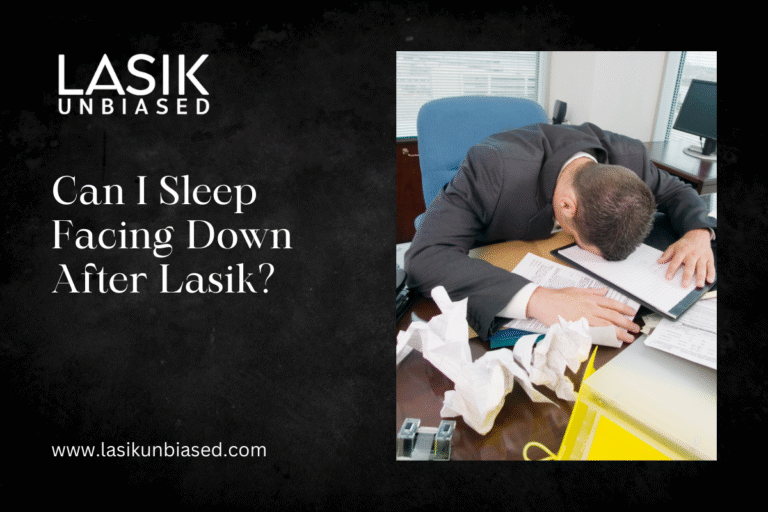No, you should avoid sleeping face down after LASIK.
This position puts unnecessary pressure on your eyes, potentially disrupting the healing process and compromising your results. Instead, follow your doctor’s post-operative care instructions carefully to ensure a seamless and successful recovery.
LASIK, short for Laser-Assisted In Situ Keratomileusis, is a common vision correction procedure that has transformed millions of lives by reducing dependence on glasses or contact lenses. While the surgery itself is quick, the healing process requires careful adherence to post-operative guidelines. One frequently asked question is about sleeping positions, particularly sleeping face down. This blog explores why you should avoid this position and what you can do to support optimal healing.
Why is Sleeping Face Down Risky After LASIK?
Sleeping on your stomach can put added pressure on your healing eyes, potentially hindering the recovery process. After LASIK, your corneal flap needs time to stabilise and heal completely. Direct pressure on the eyes can disrupt the delicate flap, increasing the risk of complications such as flap dislocation, irritation, or inflammation.
- Pressure Risks
Pressing your face into a pillow or mattress applies direct force to your eyes. This is especially risky in the first few days after surgery when the flap is most vulnerable. Even minimal pressure can interfere with the healing process, leading to discomfort or prolonged recovery.
- Risk of Infection
Sleeping face down may increase the risk of contamination if the eyes come into contact with unclean bedding or hands, though infection risk is more commonly associated with poor hygiene or improper post-operative care.
- Unconscious Rubbing
Sleeping face down could tempt you to rub your eyes unconsciously during the night. Rubbing your eyes is strictly prohibited after LASIK as it can displace the corneal flap or cause micro-tears, resulting in further complications.
Ideal Sleeping Positions Post-LASIK
Now that we’ve established why sleeping face down is a no-go, let’s discuss the recommended sleeping positions to support your recovery.
Sleeping on Your Back
Sleeping on your back is the safest position after LASIK, especially during the first week. This position keeps pressure off your eyes and ensures your head is in a neutral position, promoting uninterrupted healing.
Tips for Sleeping on Your Back:
- Use Two Pillows
Elevate your head slightly to reduce fluid buildup or swelling around your eyes.
- Sleep with an Eye Shield
LASIK surgeons typically provide a protective eye shield to wear while sleeping. This shield is specifically designed to protect your eyes, preventing inadvertent rubbing or pressure during the healing process.
- Create a Comfortable Environment
Use a supportive mattress and breathable pillows to encourage you to stay on your back throughout the night.
Sleeping on Your Side
If sleeping on your back is uncomfortable, side sleeping may be acceptable after the initial 1–2 days—provided you avoid any direct pressure on the eyes and sleep with protective shields. Make sure to avoid direct contact between your face and the pillow.
Tips for Side Sleeping:
- Use a Contoured Pillow
A pillow with a contoured design can help cradle your head and keep pressure off your eyes.
- Alternate Sides
Switch sides periodically to distribute pressure more evenly across your body.
How Long Should You Avoid Sleeping Face Down?
The critical recovery period after LASIK typically lasts one to two weeks, though your eyes will continue to heal over several months. During the initial phase, avoid sleeping face down until your doctor confirms that your eyes have healed sufficiently.
- Follow Your Doctor’s Timeline
Every patient’s healing process is unique. Your doctor will monitor your recovery during follow-up appointments and advise you when it’s safe to resume normal activities, including preferred sleeping positions.
- Err on the Side of Caution
Even after you’re cleared, continuing to sleep on your back or side—if comfortable—adds a layer of protection during the later stages of healing. However, most people can safely return to their usual sleeping position once fully healed.
Tips for a Comfortable Recovery
Beyond sleeping positions, here are some general tips to ensure a smooth recovery after LASIK:
- Wear Protective Gear
Use the eye shields or goggles provided by your doctor, especially during the first few nights. These safeguard your eyes against accidental rubbing and exposure to external irritants.
- Avoid Strain on Your Eyes
Prioritise giving your eyes plenty of rest during the first few days. Minimise screen time and avoid reading for long periods.
- Stick to the Eye Drop Routine
Your doctor will prescribe lubricant and antibiotic eye drops. Use them as directed to keep your eyes hydrated and infection-free.
- Keep Your Sleeping Area Clean
Wash your pillowcases, sheets, and blankets before surgery to ensure a clean, hygienic environment for recovery.
- Monitor for Signs of Complications
Watch for signs of infection such as redness, severe discomfort, or discharge. If you experience any unusual symptoms, please contact your doctor without delay.
Final Thoughts on Sleeping Face Down After LASIK
Avoiding face-down sleeping after LASIK is a simple but essential part of your recovery process. By following your surgeon’s advice, choosing the right sleeping position, and taking precautions, you can protect your eyes and enjoy the full benefits of your vision correction.
LASIK is a life-changing procedure, offering clearer vision and freedom from glasses or contact lenses. However, your post-operative care, including how you sleep, plays a crucial role in the success of your recovery.
For more information on LASIK care or to learn about best practices post-surgery, consult your ophthalmologist. Taking extra care now will ensure you reap the lifelong benefits of your LASIK procedure.
Common Concerns About Sleeping After LASIK
What If I Accidentally Sleep Face Down?
If you accidentally sleep face down for a short time, don’t panic. Gently revert to sleeping on your back and monitor for any discomfort or changes in vision. If you experience any issues, consult your doctor promptly.
Can I Ever Sleep Face Down Again?
Yes, once your eyes have fully healed and your doctor has given the go-ahead, sleeping face down won’t pose significant risks. For most people, this clearance happens within a few weeks after surgery.
Do I Need to Sleep Differently Long-Term?
No, you won’t need to change your sleeping position permanently. The precautions are primarily for the initial healing phase, during which your eyes are most sensitive.
What the Experts Say About Sleep and Recovery?
Ophthalmologists widely agree that diligent post-operative care is crucial to a successful LASIK outcome. Many complications—such as flap dislocation or prolonged inflammation—can be linked to avoidable behaviors like rubbing the eyes or placing direct pressure on them. Sleeping face down, particularly in the early healing phase, is one such preventable risk.


